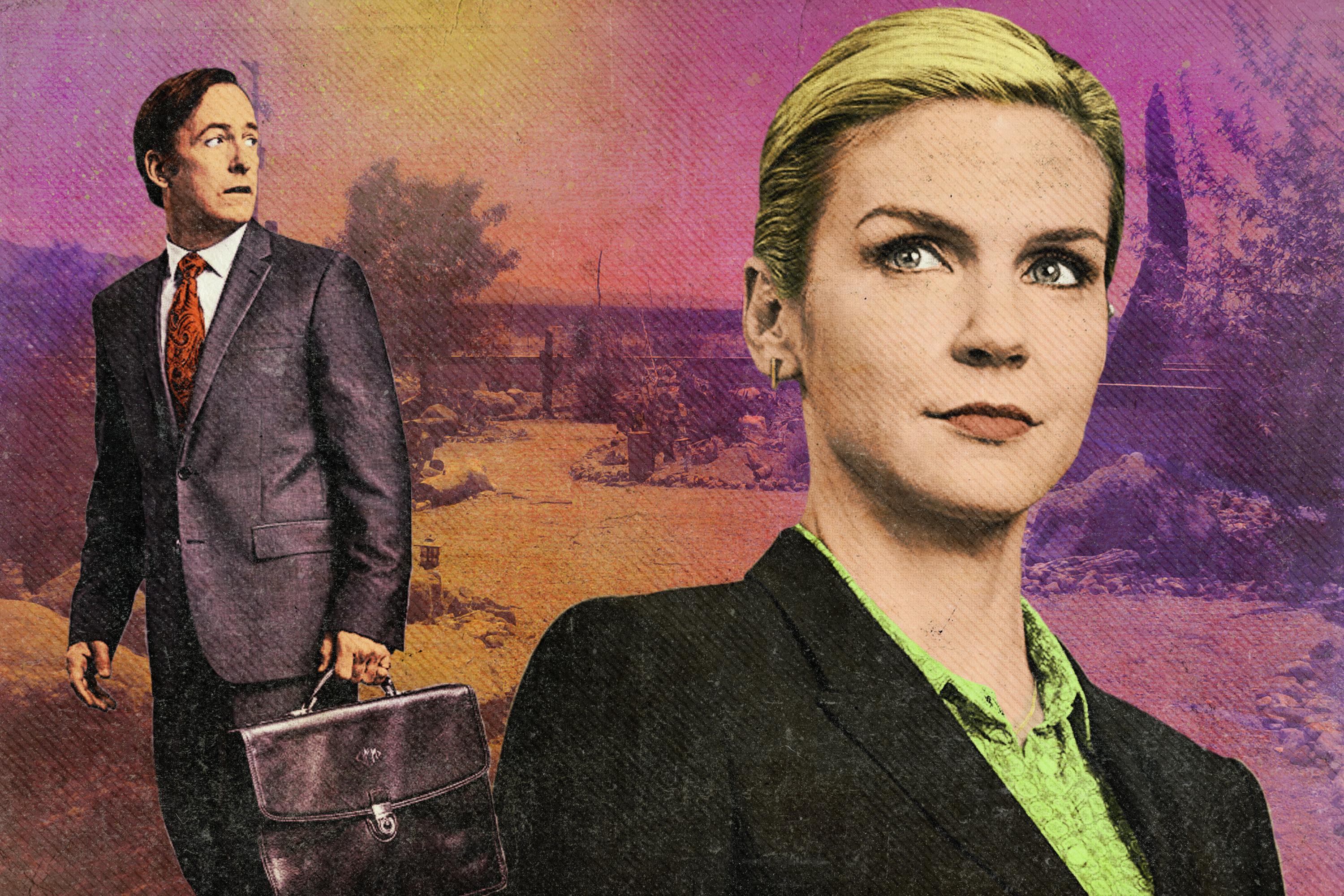The Enduring, Understated Brilliance of ‘Better Call Saul’
The AMC series has long lived in the shadow of ‘Breaking Bad,’ one of the best shows of the century. But as the spinoff enters its devastating fifth season, it’s proved that it deserves to be regarded just as highly as its predecessor.
“This is more than we talked about,” Jimmy McGill says in the fourth episode of Better Call Saul’s fourth season. Jimmy has just met up with an accomplice—Ira, whom Breaking Bad fans might recognize as the owner of Vamonos Pest, the eventual front for Walt and Jesse’s meth operation—after one of his most peculiar scams to date: After breaking into a photocopy company, Ira stole a Hummel figurine. According to Jimmy, the “Bavarian Boy” figurine the company had in its display case would be worth thousands of dollars to a serious collector. When Ira brought the figurine to a collectibles expo, a bidding war ensued, and the Bavarian Boy sold for a lot more than the pair had anticipated.
“Wow, great,” Jimmy says, with a twinge of confusion on his face. “But we both know you could’ve kept most of this. I would’ve never known the difference.” Their exchange encapsulates the ethos of the man who is becoming Saul Goodman before our eyes. There is no honor among thieves. In New Mexico, I suppose that sentiment also applies to go-to lawyers.
It’s only fitting to dissect Better Call Saul, cocreated by Peter Gould and Vince Gilligan, by starting with a little moment. While Breaking Bad was defined by the pulse-pounding and (sometimes literal) explosive thrills of Walter White’s ugly transformation into the meth kingpin Heisenberg, Better Call Saul is a slow, ruminative burn. Heisenberg went out in a blaze of neo-Nazi-killing glory; the steady devolution of Jimmy McGill into Saul Goodman can feel like a death by a thousand cuts. On AMC’s spinoff series, minor decisions and granular details stack up and define a character’s fate—it’s through that meeting with Ira, after all, that Jimmy hatches a plan to sell drop phones to criminals under the name Saul Goodman. Those criminals will become his earliest clientele when he’s reinstated as a lawyer going into the fifth season.
A character study of a sleazy lawyer becoming even sleazier can be a harder sell for the subset of Breaking Bad fans hoping for a reprisal of the show’s kinetic pace. Even the gangland side of Better Call Saul, led by Mike Ehrmantraut and Nacho Varga, is comparatively understated—the occasional sight of Gus Fring suffocating a Salamanca henchman notwithstanding. An honest-to-god front-runner for the show’s most breathtaking scene revolves around Michael McKean removing a cellphone battery from his suit pocket. (Saul-heads know!)
By avoiding becoming Breaking Bad 2.0, Better Call Saul manages to be brilliant on its own terms—it’s a series executed with craftsmanship, care, and montage-making that is unparalleled on the small screen. Yet the reason for the show’s existence also feels like the thing that’s holding it back: When it comes to the nebulous Online Discourse, it doesn’t seem like anything can stop Better Call Saul from living in Breaking Bad’s shadow. It’s sadly fitting that Better Call Saul has garnered 32 Emmy nominations but hasn’t won a single statuette.
Preaching about the greatness of Better Call Saul can sometimes feel like screaming into the void, but if there’s ever going to be a moment for the spinoff to capture the zeitgeist like Breaking Bad, the beginning of the fifth and penultimate season seems like the perfect time. Jimmy McGill has fully embraced Saul Goodman, while DEA agents Hank “Mineral Lord” Schrader and Steve Gomez have joined the growing list of Breaking Bad alums to reappear in the prequel’s timeline. The disparate story lines of Jimmy and Mike are slowly beginning to merge, which should have serious ramifications for characters whose fates aren’t sealed, while the show’s future timeline in Omaha, Nebraska, remains deliciously cryptic. Things are getting explosive—or as close to explosive as things on the series usually get. All told, Better Call Saul’s legacy shouldn’t just be one of a rare spinoff that actually works: It deserves to stand next to Breaking Bad as one of the best shows of its time.
As much as Breaking Bad revolved around Walt, the key to making that show 96.2 percent pure was Jesse Pinkman. The longer the series went on, and the more depraved Walt’s actions became, the more Jesse served as Breaking Bad’s complicated moral center: at once horrified by his mentor and complicit in many of his misdeeds (lest we forget what happened to poor Gale). Their dynamic was so essential to Breaking Bad that it’s impossible to imagine a world where Jesse was killed in the first season, as was once intended. There is a similar relationship at the heart of Better Call Saul—albeit one that is romantic, and where most audience anxiety revolves around whether a beloved character will be killed.
Kim Wexler, Jimmy’s girlfriend and moral counterweight, is nowhere to be found on Breaking Bad, so the audience is understandably meant to worry about her. At the start of the fifth season, Jimmy and Kim remain together—he’s still living in her apartment, and they even tour a house on the market—but what began as small cracks in their relationship are becoming bigger. Kim has always known, and embraced, the part of Jimmy that cuts corners and has, uh, a liberal interpretation of the law. More than once, she’s dabbled with some of his scams herself. But Kim’s tolerance for Jimmy’s cons, now that he’s practicing as Saul Goodman and ratcheting them up to a new extreme, has reached an inflection point.
Jimmy’s approach to the law has a push-pull effect within Kim. There’s an obvious thrill she derives from the two-bit scams and getting the desired outcome from a case, but the longer Kim enables or endorses Jimmy’s increasingly dubious behavior, the more guilt she begins to feel. The most startling instance comes in the Season 5 premiere, when Jimmy suggests Kim lie to a client to get him to accept a plea deal—if they were to go to trial, which the client is set on doing, he’d likely face way more jail time instead of less. The wheels spin in her head, she tricks her client into accepting the deal by claiming the DA wants to pull the current deal, and it almost immediately weighs on her conscience. (Which makes sense: This is a character whose favorite movie is, very subtly, To Kill a Mockingbird.) The prevailing concern around Kim shouldn’t be about whether or not she’ll die, but whether being in a relationship with Jimmy-cum-Saul during his moral decay is going to drag her down by association.
That Kim effortlessly vacillates between admiration and disgust for Jimmy throughout the series—and seeing those feelings quietly lean more toward disgust in the penultimate season—is not just a testament to Better Call Saul’s writing, but also Rhea Seehorn’s incredible work. Seehorn is delivering, and I don’t think I’m being hyperbolic here, one of the most nuanced and underappreciated performances on television. That the Emmys haven’t even nominated her once is the Television Academy’s most embarrassing oversight since it ignored Carrie Coon’s work on The Leftovers. (If you know me at all, that’s like calling Rhea Seehorn acting royalty, and you’re goddamn right she is.)
Kim Wexler is Better Call Saul’s beating heart, and as much as the series leans into the tragic inevitability of Jimmy and Mike getting to where they’re going to be in Breaking Bad, it creates a similar pathos by leaving Kim’s fate uncertain. Where it once felt like she could occasionally weaponize Jimmy’s tricks for the good of a client, his new identity is chipping away at Kim’s core of decency. Her future, however murky, seems inevitably tragic.
While Breaking Bad and Better Call Saul have a lot of surface similarities—settings, characters, gorgeous desert vistas that would make you think the enterprise was sponsored by the New Mexico tourism board if not for all that pesky meth and murder—the overarching idea both series share is that actions have consequences. Breaking Bad existed in a moral universe; karma was its great equalizer. The biggest problem for that series was that, like The Sopranos, certain viewers endorsed Walt’s behavior instead of vilifying it; on a baser level, it could look really badass in a “playing Grand Theft Auto: New Mexico” sort of way. By far, the worst part of Breaking Bad’s legacy is the way hordes of fans treated Skyler White for the crime of reacting like any rational human would when their partner became an aspiring drug lord.
Better Call Saul operates in the same moral universe, but its consequences aren’t flashy enough that you’d see Saul Goodman posters in a real-life college dorm room. Violent antiheroes like Walter White and Tony Soprano are always going to seem cool to a subset of viewers; the closest Saul Goodman gets to that status is being the centerpiece of memes implying he’s the only lawyer shady enough to deal with soccer’s governing bodies. But as a result, Better Call Saul’s karmic philosophy is harder to misread—unless you have a serious affinity for scam artistry—and easier to streamline.
Jimmy McGill has equated being a lawyer to being a good salesman, and so to entice his drop-phone clients, he offers “50 percent off” legal services to nonviolent offenders. Kim worries that he’s setting a dangerous precedent; Jimmy assures her it will be fine. Sure enough, we see two burnouts in the mold of Jesse Pinkman tear through Albuquerque on a wild night off the high of, well, drugs—but they also repeat “50 percent off!” to each other like a sordid mantra.
In the micro, the two men don’t get up to anything too terrible—a little public urination here, a good deal of vandalism there—but it’s the implications of Saul’s presence that’s startling in the macro. In Breaking Bad, we spent so much time dealing with the consequences of Walt’s actions that it was easy to forget how complicit Saul is in enabling Albuquerque’s underbelly. This was all a slippery slope from the comparatively harmless act of profiting off swapped-out Hummel figurines. Jesse Pinkman said it best: “You don’t want a criminal lawyer. You want a criminal lawyer.”
Whereas, in hindsight, Walter White’s five-season transformation into Heisenberg feels like a show peeling the presentable layers off a monster, Jimmy’s fate feels like the result of hundreds of little moments and compromises that build into a new identity. Walt was always Heisenberg; becoming Saul Goodman took a lifetime of bad decisions and negative experiences. The way Jimmy’s caring yet spiteful brother Chuck consistently denied him the validation he craved as a lawyer; the slow but surely inevitable dissolution of his relationship with Kim; the persistent belief that the system is always working against the little guy, which Jimmy uses to rationalize cutting legal corners. The tragedy of Jimmy McGill is that he made Saul Goodman a self-fulfilling prophecy.
Once Jesse was freed from neo-Nazi captivity at the end of Breaking Bad, the series left the fate of Walt’s former protégé ambiguous. But unless you’ve been living under a rock for the past year, you know where our guy ended up. El Camino, Vince Gilligan’s 2019 movie sequel, showed how Jesse evaded authorities in New Mexico on his way to a second (and hopefully more peaceful) life in Alaska. The film was a painful reminder of just how much hell Jesse went through—from Walt to Todd and everything in between—and that the character earned a path to redemption through moral reckoning.
Does Saul Goodman deserve the same fate? If the prevailing criticism of a Saul-led prequel series is that we know where he’s going to end up, then Better Call Saul’s continued deployment of “Gene Takovic” is a reminder that not everything in this universe is set in stone.
In every season, Better Call Saul has shown brief black-and-white flash-forwards of Jimmy/Saul working as a Cinnabon employee in Omaha under the name Gene Takovic. (Like Jesse, he stashed enough money to use the services of the late Robert Forster’s Ed the “Disappearer.”) These Gene check-ins have been, even by Better Call Saul’s standards, absurdly spare—half the time the vignettes come across as Cinnabon sponcon by way of a monochromatic filter.
But these flash-forwards, which make up around 15 total minutes of Better Call Saul’s run thus far, paint a bleak portrait of a man consumed by regret and paranoia that he’s eventually going to get caught. (It probably doesn’t help matters that Gene sports big glasses and a hilariously thick mustache, looking like a caricature of a fugitive in hiding.) AMC has pretty much forbade critics from disclosing any details about Season 5’s Gene check-in, but I can tell you it’s the most substantive one to date—which, admittedly, is a low bar to clear.
Gene Takovic is Better Call Saul’s ultimate payoff, delivered in a super slow burn for a show that’s made a habit of taking its sweet time. I have a sneaking suspicion the sixth and final season will spend a lot of time—perhaps close to a full season?—with Jimmy-as-Gene, providing a footnote to the one main Breaking Bad character whose fate remains a giant question mark. Where will this chameleonic lawyer land on the Jesse-to-Walt spectrum? Does Jimmy warrant a second chance, or should he pay for his crimes, even though they’re more trivial than those committed by Heisenberg?
It’s truly hard to say; there’s enough humanity in Jimmy McGill that it’s easy to sympathize with him—especially in the early seasons, when he was constantly demeaned by Chuck. But as the character approaches a full-scale embrace of Saul Goodman, what once came across as a wacky lawyer with even wackier suits on Breaking Bad now feels downright malignant. This is a man who’s fully crossed over into being a cold, empty-hearted manipulator. The only solace we can take is knowing Jimmy McGill is capable of shedding his own self, as he’s done many times before. What will that mean when he’s no longer Saul Goodman, and how bad are things going to get in the meantime before the series catches up to Breaking Bad? Sadly, I suspect it’s not all good, man.

